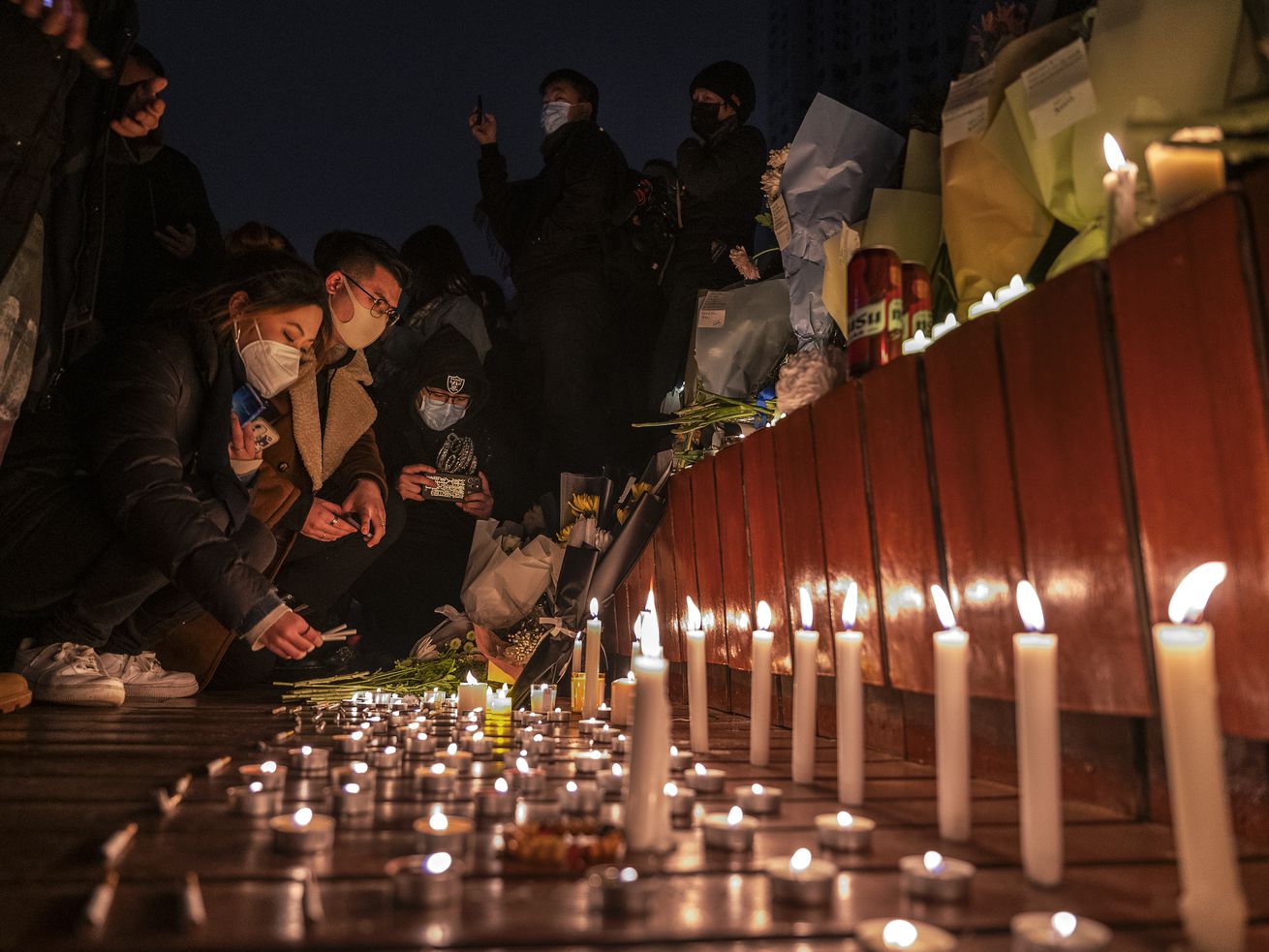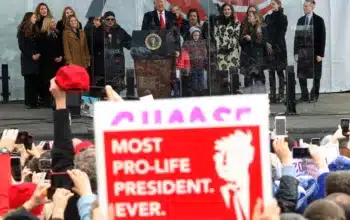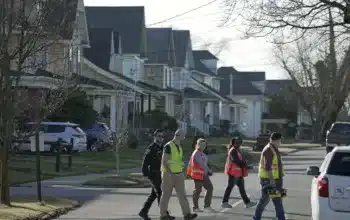In cities across China, people are protesting Xi Jinping’s Covid policy — and even demanding his resignation.
A fire leads to angry protests in the home region of a repressed ethnic minority, a labor protest turns violent at a Foxconn factory, student and citizen protests break out in Shanghai, Beijing and beyond. At first, they may seem unrelated — but underpinning it all is boiling-over frustration with China’s zero-Covid lockdown policy.
On Saturday, protests erupted in Urumqi, the capital of Xinjiang, after a Thursday apartment fire reportedly killed 10. Though information from this part of China is particularly difficult to verify due not just to Covid lockdowns — which have been active in Xinjiang for more than 100 days — but also because of the Xi regime’s desire to shield its treatment of ethnic Uyghur people from international scrutiny.
According to some experts and Uyghur scholars and activists, the fire occurred in a majority Uyghur part of the city, and Uyghur families have been the primary victims of the fire. The local government has been circumspect regarding the number dead and the circumstances around their deaths, but several accounts indicate that the Covid-19 protocols prevented emergency services from reaching those trapped in the fire.
Although it seems Uyghur lives have been the most affected by the fire and the Covid protocols in Xinjiang, they’re much less likely to protest in Urumqi or elsewhere due to the severe restrictions on their lives, and the possibility that any protest will be understood as a terrorist threat by Beijing and local authorities.
“There has been forced starvation. People had no access to food supply” under the lockdown, according to Ablimit Baki Elterish, a professor of Chinese and Uyghur at the University of Manchester. People have also “lost the source of income” due to lockdowns, and “Confinement to homes have made many urban Uyghurs [unable] to buy daily necessities,” he said.
Many of the protesters in Urumqi are actually ethnic Han Chinese, as Uyghur human rights lawyer Rayhan Asat noted on Twitter.
“Han Chinese people know they will not be punished if they speak against the lockdown,” one Uyghur woman in Urumqi told the Associated Press. “Uyghurs are different. If we dare say such things, we will be taken to prison or to the camps.”
Protests are boiling over after months of frustration and fear
While the protests in Urumqi are unique to that population, they were a product of the way zero-Covid policies are enacted in Xinjiang. Related protests online and in real life have been gaining momentum — in Shanghai, Beijing, Chengdu, and Wuhan, among others — in some cases even explicitly urging Xi to step down over the Covid-19 protocols he’s attempted to make a signature policy position.
Xi’s zero-Covid plan involves strict lockdowns, seen in other parts of the country like Shanghai earlier this year. Shanghai’s spring lockdown saw residents unable to access food, medicine, and medical care. Beijing’s recent Covid-19 surge and potential lockdown caused a run on some grocery delivery services, Bloomberg reported earlier this week, as residents of the capital city tried to prepare for the worst — not just a Covid-19 spike, but the fear of sweeping, city-wide lockdowns like the kind that smothered Beijing earlier this year.
As William Hurst, a professor of Chinese political science at Cambridge University wrote on Twitter, “What’s happened in the past 24 hours is novel in that protesters have appeared on the streets in multiple cities with apparent knowledge of what is happening in other parts of the country. They’re all mobilising around #Covid, but this is refracted through distinct lenses,” whether that’s labor, local governance, student protests, rural protests, or systematic political dissent, as he put it.
“This is a broad sweeping program, and it’s hitting across all levels of Chinese society,” University of Manchester professor David Stroup told Vox.
In some places, protesters are not just calling for an end to the Covid-19 protocols, but for the institution of democracy and for a free press — something nearly unheard of in recent decades. Some are even demanding an end to Xi’s tenure and the end of the Chinese Communist Party. That’s not totally without precedent in the history of the Communist party; massive pro-liberalization and pro-democracy protests occurred around the country in the spring of 1989, manifesting in the historic student demonstrations around Tiananmen Square.
Protesters this year came out around the 20th Party Congress, too, most notably unfurling a banner over a Beijing bridge that read, “Food not Covid tests; Reform not Cultural Revolution; Freedom not Lockdown; Votes not leaders; Dignity not lies; Citizens not minions.” That was an especially potent — and potentially dangerous — message given the context. It was during the Party Congress in October that Xi cemented his third term as president of China and his continuing leadership of the Chinese Communist Party.
Still, dissent has only become more visible since then. Last week, hundreds of workers at the Foxconn iPhone plant in central China’s Zhengzhou city protested after weeks of Covid-19 restrictions kept them confined to their dorms or homes, with reports of poor food distribution logistics and widespread fear. The final straw appeared to be reports that Foxconn would delay bonus payments promised to new workers recruited after previous employees quit or fled the factory compound due to the company’s inability to manage outbreaks.
Subtle online protest is fairly common in Chinese social media, but some of that has bled into real life, including at universities like Tsinghua University, protesters hold up blank pieces of paper in a silent, practically un-censorable protest. The protests happening in Shanghai, Nanjing, and elsewhere carry different risks than those online, as Chinese citizens are already seeing, Stroup said, including, “the dispersal and arrests of protesters in Shanghai last night and the increased police presence along particular parts of Urumqi Road in Shanghai today.”
In Urumqi itself, there are already SWAT officers monitoring the protests “to establish a very clear and powerful message that there is a line and that the police are going to restore order and make arrest[s] if need be,” Stroup said.
None of this means Xi Jinping is going down
Although it’s hard to overstate how unusual the scale of the protests are, at least in mainland China, this doesn’t spell the end of Xi Jinping or the Chinese Communist Party. In fact, if the past is any indication, it means further crackdowns are likely.
Despite the protests around the 20th Party Congress, Xi sent some extremely powerful messages at the time about just who was in charge. Not only was the comparatively liberal former President Hu Jintao ejected from the proceedings on the final day of the event, but the appointments to the Politburo and Standing Committee were stacked with loyalists likely to carry out his vision for China’s future. In fact, Xi’s future party deputy, Li Qiang, oversaw the chaotic Shanghai lockdown this spring.
Xi also didn’t appoint a successor at the Congress and amended the constitution in 2018 to allow him more than the typical two terms in power — just two indications that he might be setting himself up to be China’s leader for life.
But despite Xi’s apparent iron grip on China, the proliferation of the protests in cities throughout the country indicate that information is spreading quickly, enabling people to mobilize even though an army of censors blocks words or phrases that indicate displeasure or protest.
“Even the authoritarian governments, they still have to take this mass reaction into account, or else will lose the cooperation from the society. We’re going to expect that [the central government] is going to improve the policy implementation, even though the policy itself is not going to change,” Yanzhong Huang, a senior fellow for global health at the Council on Foreign Relations, told Vox back in April regarding the Shanghai protests.
To that end, there have apparently been changes in the zero-Covid policy, as Bloomberg reported earlier this month. The new guidelines, intended to ease the implementation of the policy, include providing adequate supplies and food to people in quarantine, reducing quarantine time, promoting vaccination and boosting among older people, and 17 other specific points. There has also been a more low-key approach to restrictions in Beijing; rather than blanket restrictions, authorities are using neighborhood channels and WeChat to impose targeted lockdowns which, according to Bloomberg, have touched every region in the city. Authorities in Xinjiang also claimed Saturday that they would ease Covid restrictions in Urumqi and Korla, another city in Xinjiang, according to the Associated Press, as well as opening up transport within the region and between Urumqi and four other Chinese cities.
The Urumqi fire, Stroup noted, seems to have solidified the understanding among a part of the Chinese public that anyone could be subject to totalizing lockdowns — not just ethnic minorities, or those living where there’s a huge outbreak — which could jeopardize their lives. That’s a unifying notion, but it’s unifying against the state, as opposed to under it, despite Xi’s best efforts.
Still, there’s no reason to imagine that these protests, widespread though they are, will result in Xi’s overthrow. In fact, if the Hong Kong protests of 2019 and 2020 are any indication, the opposite is true; such outspoken rebellion will only give the government more incentive to crack down on what freedoms people have.
“One thing I would urge anyone who is watching these events unfold to do is be careful in assessing what these types of protest portend for things like political change,” Stroup told Vox. “While the party-state is certainly very concerned about maintaining legitimating narratives about the party’s provision of stability and harmony, the demands of those protesting so far mostly center on ending zero-Covid. How this might influence things like public perception of Xi or the party itself are difficult to discern, and this will largely be borne out over time.”
Author: Ellen Ioanes
Read More



